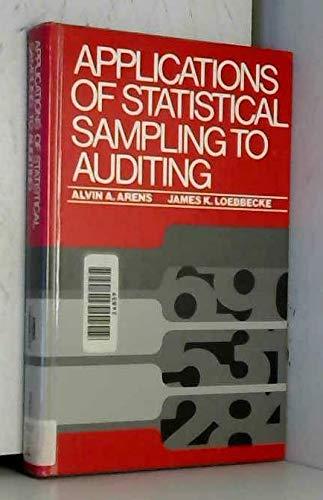The following questions relate to determining the computed upper precision limit in simple attributes. a. For each
Question:
The following questions relate to determining the computed upper precision limit in simple attributes.
a. For each column, 1 through 5, determine the computed upper precision limit from the appropriate tables.

b. Using your understanding of the relationship between the four factors above and the computed upper precision limit, state the effect on the computed upper precision limit (increase or decrease) of changing each of the following factors while the other three are held constant:
(i) A decrease in the confidence level
(ii) A decrease in the population value
(iii) A decrease in the sample size
(iv) A decrease in the number of occurrences in the sample
c. Compare your answers in part b with the results you determined in part a. Which of the four factors appears to have the greatest effect on the computed upper precision limit? Which one appears to have the least effect ?
d. Why is it necessary to compare the computed upper precision limit in dollars with the acceptable upper precision limit in dollars?
e. Compare your answers in parts a and b to the corresponding questions in problem 3-21. Explain why your answers are the same or different.
Problem 3-21:
The following questions relate to determining the computed upper precision limit in attributes sampling.
a. For each of the columns numbered 1 through 8, determine the computed upper precision limit from the appropriate table in Figures 3-2 and 3-3. Wherever the sample size is more than 10 percent of the population, adjust the computed upper precision limit with the finite correction factor.

b. Using your understanding of the relationship between the four factors above and the computed upper precision limit, state the effect on the computed upper precision limit (increase or decrease) of changing each of the following factors while the other three are held constant:
(i) A decrease in the confidence level
(ii) A decrease in the population size
(iii) A decrease in the sample size
(iv) A decrease in the number of occurrences in the sample
c. Compare your answers in part b with the results you determined in part a. Which of the four factors appears to have the greatest effect on the computed upper precision limit ? Which one appears to have the least effect ?
d. Why is it necessary to compare the computed upper precision limit with the desirable upper precision limit?


Step by Step Answer:

Applications Of Statistical Sampling To Auditing
ISBN: 9780130391568
1st Edition
Authors: Alvin A. Arens, James K. Loebbecke





